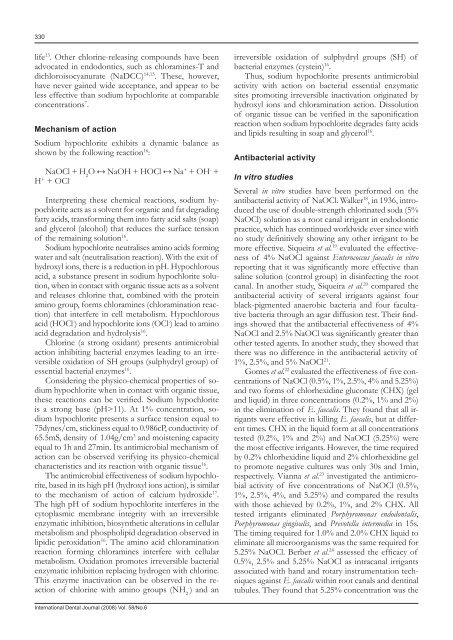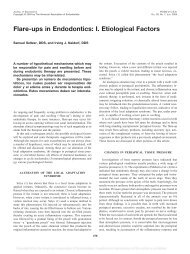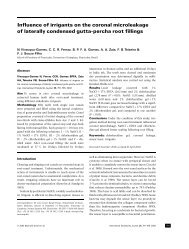Sodium hypochlorite in endodontics
Sodium hypochlorite in endodontics
Sodium hypochlorite in endodontics
Create successful ePaper yourself
Turn your PDF publications into a flip-book with our unique Google optimized e-Paper software.
330<br />
life 13 . Other chlor<strong>in</strong>e-releas<strong>in</strong>g compounds have been<br />
advocated <strong>in</strong> <strong>endodontics</strong>, such as chloram<strong>in</strong>es-T and<br />
dichloroisocyanurate (NaDCC) 14,15 . These, however,<br />
have never ga<strong>in</strong>ed wide acceptance, and appear to be<br />
less effective than sodium <strong>hypochlorite</strong> at comparable<br />
concentrations 7 .<br />
Mechanism of action<br />
<strong>Sodium</strong> <strong>hypochlorite</strong> exhibits a dynamic balance as<br />
shown by the follow<strong>in</strong>g reaction16 :<br />
NaOCl + H 2 O ↔ NaOH + HOCl ↔ Na + + OH - +<br />
H + + OCl -<br />
Interpret<strong>in</strong>g these chemical reactions, sodium <strong>hypochlorite</strong><br />
acts as a solvent for organic and fat degrad<strong>in</strong>g<br />
fatty acids, transform<strong>in</strong>g them <strong>in</strong>to fatty acid salts (soap)<br />
and glycerol (alcohol) that reduces the surface tension<br />
of the rema<strong>in</strong><strong>in</strong>g solution16 .<br />
<strong>Sodium</strong> <strong>hypochlorite</strong> neutralises am<strong>in</strong>o acids form<strong>in</strong>g<br />
water and salt (neutralisation reaction). With the exit of<br />
hydroxyl ions, there is a reduction <strong>in</strong> pH. Hypochlorous<br />
acid, a substance present <strong>in</strong> sodium <strong>hypochlorite</strong> solution,<br />
when <strong>in</strong> contact with organic tissue acts as a solvent<br />
and releases chlor<strong>in</strong>e that, comb<strong>in</strong>ed with the prote<strong>in</strong><br />
am<strong>in</strong>o group, forms chloram<strong>in</strong>es (chloram<strong>in</strong>ation reaction)<br />
that <strong>in</strong>terfere <strong>in</strong> cell metabolism. Hypochlorous<br />
acid (HOCl- ) and <strong>hypochlorite</strong> ions (OCl- ) lead to am<strong>in</strong>o<br />
acid degradation and hydrolysis16 .<br />
Chlor<strong>in</strong>e (a strong oxidant) presents antimicrobial<br />
action <strong>in</strong>hibit<strong>in</strong>g bacterial enzymes lead<strong>in</strong>g to an irreversible<br />
oxidation of SH groups (sulphydryl group) of<br />
essential bacterial enzymes16 .<br />
Consider<strong>in</strong>g the physico-chemical properties of sodium<br />
<strong>hypochlorite</strong> when <strong>in</strong> contact with organic tissue,<br />
these reactions can be verified. <strong>Sodium</strong> <strong>hypochlorite</strong><br />
is a strong base (pH>11). At 1% concentration, sodium<br />
<strong>hypochlorite</strong> presents a surface tension equal to<br />
75dynes/cm, stick<strong>in</strong>ess equal to 0.986cP, conductivity of<br />
65.5mS, density of 1.04g/cm3 and moisten<strong>in</strong>g capacity<br />
equal to 1h and 27m<strong>in</strong>. Its antimicrobial mechanism of<br />
action can be observed verify<strong>in</strong>g its physico-chemical<br />
characteristics and its reaction with organic tissue16 .<br />
The antimicrobial effectiveness of sodium <strong>hypochlorite</strong>,<br />
based <strong>in</strong> its high pH (hydroxyl ions action), is similar<br />
to the mechanism of action of calcium hydroxide17 .<br />
The high pH of sodium <strong>hypochlorite</strong> <strong>in</strong>terferes <strong>in</strong> the<br />
cytoplasmic membrane <strong>in</strong>tegrity with an irreversible<br />
enzymatic <strong>in</strong>hibition, biosynthetic alterations <strong>in</strong> cellular<br />
metabolism and phospholipid degradation observed <strong>in</strong><br />
lipidic peroxidation16 . The am<strong>in</strong>o acid chloram<strong>in</strong>ation<br />
reaction form<strong>in</strong>g chloram<strong>in</strong>es <strong>in</strong>terfere with cellular<br />
metabolism. Oxidation promotes irreversible bacterial<br />
enzymatic <strong>in</strong>hibition replac<strong>in</strong>g hydrogen with chlor<strong>in</strong>e.<br />
This enzyme <strong>in</strong>activation can be observed <strong>in</strong> the re-<br />
- action of chlor<strong>in</strong>e with am<strong>in</strong>o groups (NH ) and an<br />
2<br />
International Dental Journal (2008) Vol. 58/No.6<br />
irreversible oxidation of sulphydryl groups (SH) of<br />
bacterial enzymes (cyste<strong>in</strong>) 16 .<br />
Thus, sodium <strong>hypochlorite</strong> presents antimicrobial<br />
activity with action on bacterial essential enzymatic<br />
sites promot<strong>in</strong>g irreversible <strong>in</strong>activation orig<strong>in</strong>ated by<br />
hydroxyl ions and chloram<strong>in</strong>ation action. Dissolution<br />
of organic tissue can be verified <strong>in</strong> the saponification<br />
reaction when sodium <strong>hypochlorite</strong> degrades fatty acids<br />
and lipids result<strong>in</strong>g <strong>in</strong> soap and glycerol 16 .<br />
Antibacterial activity<br />
In vitro studies<br />
Several <strong>in</strong> vitro studies have been performed on the<br />
antibacterial activity of NaOCl. Walker18 , <strong>in</strong> 1936, <strong>in</strong>troduced<br />
the use of double-strength chlor<strong>in</strong>ated soda (5%<br />
NaOCl) solution as a root canal irrigant <strong>in</strong> endodontic<br />
practice, which has cont<strong>in</strong>ued worldwide ever s<strong>in</strong>ce with<br />
no study def<strong>in</strong>itively show<strong>in</strong>g any other irrigant to be<br />
more effective. Siqueira et al. 19 evaluated the effectiveness<br />
of 4% NaOCl aga<strong>in</strong>st Enterococcus faecalis <strong>in</strong> vitro<br />
report<strong>in</strong>g that it was significantly more effective than<br />
sal<strong>in</strong>e solution (control group) <strong>in</strong> dis<strong>in</strong>fect<strong>in</strong>g the root<br />
canal. In another study, Siqueira et al. 20 compared the<br />
antibacterial activity of several irrigants aga<strong>in</strong>st four<br />
black-pigmented anaerobic bacteria and four facultative<br />
bacteria through an agar diffusion test. Their f<strong>in</strong>d<strong>in</strong>gs<br />
showed that the antibacterial effectiveness of 4%<br />
NaOCl and 2.5% NaOCl was significantly greater than<br />
other tested agents. In another study, they showed that<br />
there was no difference <strong>in</strong> the antibacterial activity of<br />
1%, 2.5%, and 5% NaOCl21 .<br />
Gomes et al. 22 evaluated the effectiveness of five concentrations<br />
of NaOCl (0.5%, 1%, 2.5%, 4% and 5.25%)<br />
and two forms of chlorhexid<strong>in</strong>e gluconate (CHX) (gel<br />
and liquid) <strong>in</strong> three concentrations (0.2%, 1% and 2%)<br />
<strong>in</strong> the elim<strong>in</strong>ation of E. faecalis. They found that all irrigants<br />
were effective <strong>in</strong> kill<strong>in</strong>g E. faecalis, but at different<br />
times. CHX <strong>in</strong> the liquid form at all concentrations<br />
tested (0.2%, 1% and 2%) and NaOCI (5.25%) were<br />
the most effective irrigants. However, the time required<br />
by 0.2% chlorhexid<strong>in</strong>e liquid and 2% chlorhexid<strong>in</strong>e gel<br />
to promote negative cultures was only 30s and 1m<strong>in</strong>,<br />
respectively. Vianna et al. 23 <strong>in</strong>vestigated the antimicrobial<br />
activity of five concentrations of NaOCl (0.5%,<br />
1%, 2.5%, 4%, and 5.25%) and compared the results<br />
with those achieved by 0.2%, 1%, and 2% CHX. All<br />
tested irrigants elim<strong>in</strong>ated Porphyromonas endodontalis,<br />
Porphyromonas g<strong>in</strong>givalis, and Prevotella <strong>in</strong>termedia <strong>in</strong> 15s.<br />
The tim<strong>in</strong>g required for 1.0% and 2.0% CHX liquid to<br />
elim<strong>in</strong>ate all microorganisms was the same required for<br />
5.25% NaOCl. Berber et al. 24 assessed the efficacy of<br />
0.5%, 2.5% and 5.25% NaOCl as <strong>in</strong>tracanal irrigants<br />
associated with hand and rotary <strong>in</strong>strumentation techniques<br />
aga<strong>in</strong>st E. faecalis with<strong>in</strong> root canals and dent<strong>in</strong>al<br />
tubules. They found that 5.25% concentration was the





